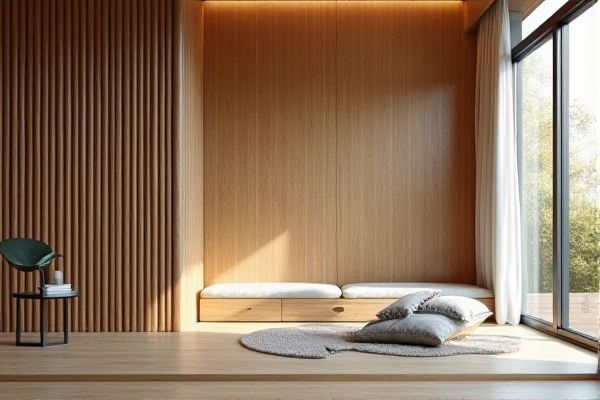
Reed panels offer a natural, lightweight option with excellent acoustic and thermal insulation, while bamboo panels provide superior durability and eco-friendly strength due to their dense fiber structure. Explore the rest of the article to discover which material best suits Your project needs and environmental goals.
Table of Comparison
| Feature | Reed Panel | Bamboo Panel |
|---|---|---|
| Material Source | Natural reed grass | Fast-growing bamboo stalks |
| Durability | Moderate, prone to weather damage | High, resistant to moisture and insects |
| Weight | Lightweight | Moderate weight |
| Environmental Impact | Renewable, low carbon footprint | Sustainable, carbon negative |
| Cost | Economical, affordable | Moderate to high cost |
| Uses | Wall panels, decorative screens | Flooring, furniture, wall panels |
| Maintenance | Requires regular sealing/protection | Low maintenance |
Introduction to Reed and Bamboo Panels
Reed panels consist of tightly bound natural reeds renowned for their lightweight nature and excellent acoustic properties, making them ideal for soundproofing and decorative purposes. Bamboo panels offer superior durability and sustainability, crafted from fast-growing bamboo stalks that provide strength, moisture resistance, and eco-friendly benefits. Selecting between reed and bamboo panels depends on your need for either lightweight acoustics or long-lasting structural support in interior design or construction projects.
Material Composition: Reed vs Bamboo
Reed panels are composed of thin, flexible stalks from aquatic grasses, offering lightweight and natural moisture resistance properties. Bamboo panels consist of dense, fast-growing bamboo fibers that provide superior strength, durability, and environmental sustainability. Choosing between reed and bamboo panels depends on your project's needs for flexibility and aesthetic appeal versus structural integrity and longevity.
Sustainability and Environmental Impact
Reed panels utilize fast-growing reeds that absorb high levels of CO2, making them a renewable resource with minimal environmental footprint. Bamboo panels offer exceptional sustainability due to bamboo's rapid growth rate and ability to regenerate without replanting, reducing deforestation pressures. Choosing between reed and bamboo panels depends on Your project's specific environmental goals and local availability, as both materials contribute to eco-friendly building practices.
Aesthetic Differences and Design Applications
Reed panels offer a natural, textured appearance with warm golden tones ideal for rustic and bohemian interior designs, while bamboo panels provide a sleek, modern look with smooth surfaces and a uniform grain pattern suited for contemporary and eco-friendly spaces. Reed panels excel in creating cozy, organic atmospheres with their irregular patterns, whereas bamboo panels support minimalist aesthetics and can be easily incorporated into furniture, wall coverings, and flooring for a clean, sustainable finish. Your choice between these materials depends on whether you want a more tactile, earthy vibe or a polished, streamlined design element.
Durability and Longevity Comparison
Reed panels typically offer moderate durability but are more prone to wear and environmental damage compared to bamboo panels, which are known for their exceptional strength and resistance to moisture, pests, and decay. Bamboo panels maintain their structural integrity longer, making them a preferred choice for applications requiring longevity and robustness. Selecting bamboo panels for your project ensures enhanced durability and a longer lifespan under varied conditions.
Installation Process: Reed Panel vs Bamboo Panel
Reed panels offer a lightweight and flexible installation process, often requiring simple fastening methods such as staples or nails to secure them onto existing frames or surfaces. Bamboo panels typically demand more precise preparation and installation due to their rigidity and density, often involving screws or specialized fasteners to ensure stability and durability. Both materials benefit from proper surface treatment and sealing to enhance longevity and resistance to environmental factors.
Maintenance and Care Requirements
Reed panels require regular dusting and occasional sealing to prevent moisture damage and maintain durability in humid environments. Bamboo panels demand periodic cleaning with a damp cloth and the application of natural oils or sealants to preserve their strength and resist cracking or warping. Both materials benefit from avoiding excessive direct sunlight and damp conditions to extend their lifespan and retain aesthetic appeal.
Cost Analysis: Reed Panel vs Bamboo Panel
Reed panels generally offer a lower cost compared to bamboo panels due to the faster growth rate and abundance of reed plants, making them a budget-friendly option for eco-conscious projects. Bamboo panels tend to have a higher initial price because of the more intensive harvesting and processing methods, though their durability can provide better long-term value. Evaluating total expenses, including installation and maintenance, reed panels typically require less investment upfront, while bamboo panels may save money over time through enhanced lifespan and strength.
Acoustic and Insulation Properties
Reed panels offer excellent sound absorption due to their fibrous structure, making them ideal for reducing noise in indoor environments. Bamboo panels provide superior thermal insulation properties thanks to their dense cellular makeup, which helps maintain consistent indoor temperatures. Both materials contribute to sustainable building practices, with reed panels excelling in acoustic treatments and bamboo panels enhancing energy efficiency through insulation.
Best Uses and Recommendations
Reed panels excel in decorative applications and sound absorption, making them ideal for interior wall coverings, ceiling treatments, and natural room dividers. Bamboo panels offer superior strength and durability, recommended for flooring, furniture, and outdoor decking where resilience against wear and moisture is essential. Both materials provide eco-friendly alternatives, with reed panels best suited for lightweight, aesthetic uses and bamboo panels preferred for structural and heavy-duty purposes.
 homyna.com
homyna.com